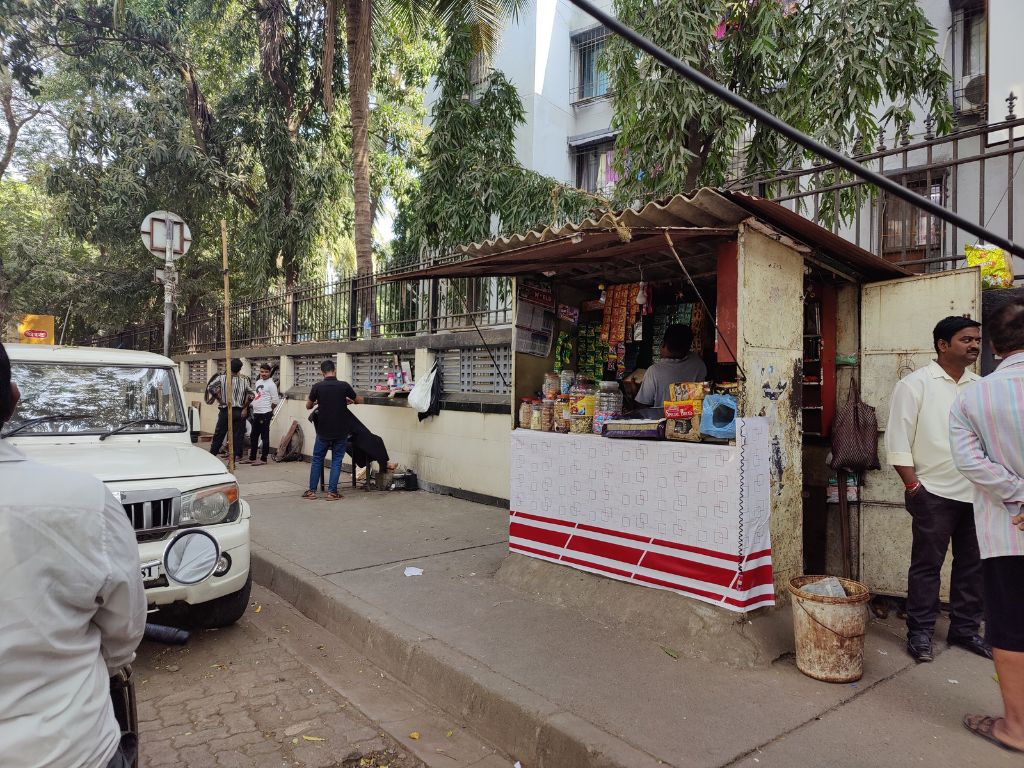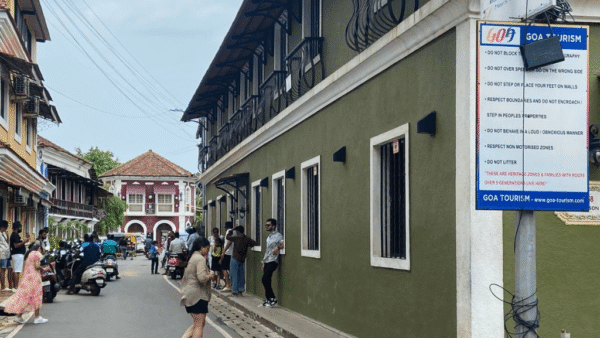In urban road plans, the formal road space has vehicular lanes and the remaining space is set aside, often without thought, for the informal part of the city which includes pedestrians, hawkers, homeless, and others. The informal, then, proliferates in its space with its own patterns depending on who occupies it, how people occupy, and move within it. This informal is our footpaths or pavements, or sidewalks as they are called in the rest of the world, and we interact with it regularly. A quick trip to the nearby vendor for dhaniya, dahi, sutta is part of daily life for many in cities.
The informality provides us with a shared experience of a city through everyday actions and routines, and forms an integral part of the urban experience. The informality is sometimes seen as obstacles by pedestrians which sets off the vexed conflict between them and vendors. While our footpaths seem contentious, there is no denying that their use by a wide variety of people makes the space feel more lively.
Footpaths in a neighbourhood also help crystallise its identity – a leafy and inviting stretch versus a stretch of road without footpath space – offers locals a shared public space, and helps build a community. A research paper[1] found that “associations with individuals, places, and events contribute to a sense of community familiarity and belonging. Places that help shape pedestrians’ attitudes, provide continuity from past to present, often cater for ordinary but essential day-to-day functions, and help to establish the identity of their community, become meaningful to neighbours and attain a social value and significance.”
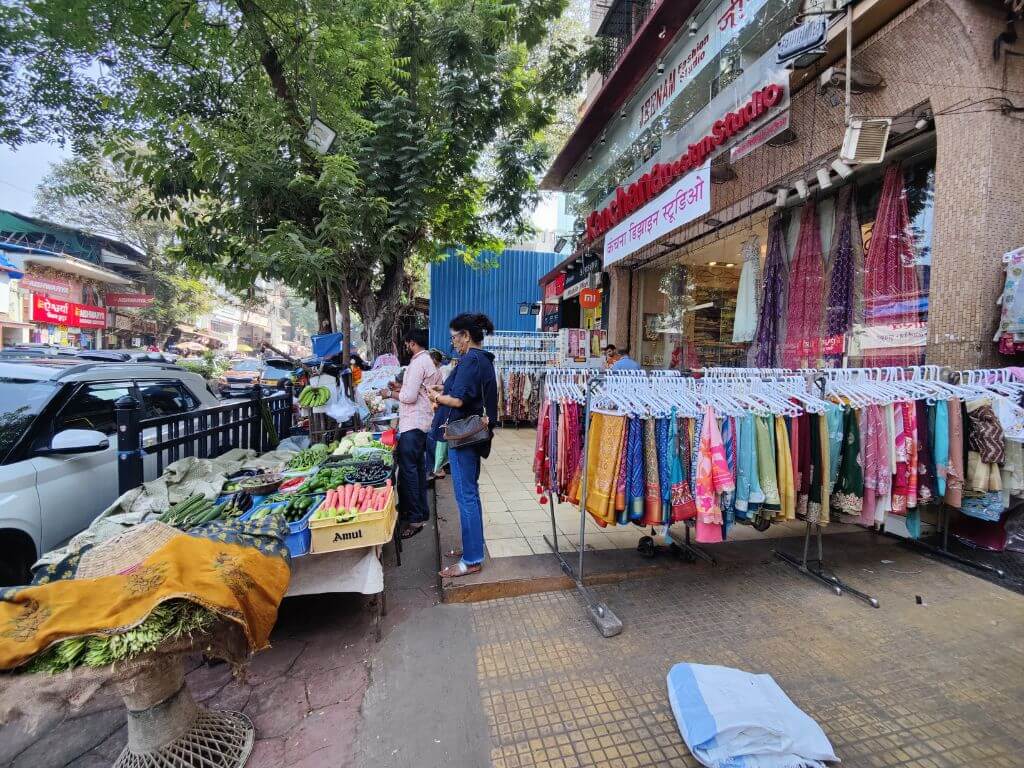
Photo: Shivani Dave
Affordable food or working-class food is found on footpaths in most cities; indeed, street food is in a genre of its own in most cities.
In 1995, Mumbai got its Zunka Bhakar scheme, an initiative by the Shiv Sena-led Government of Maharashtra, to offer a local and hearty plate of food cheaply and give licences to unemployed to run these small food stalls – all on footpaths or along street edges. “Over the years, the zunka bhakar kendras extended themselves into the space of the street, occupying more space on the sidewalks and sometimes even the carriageways. Some also provided seating arrangements for customers.”[2] This legitimate use of space for hawkers came with its profits for the poor and the unemployed, but it also meant that footpaths were unavailable to other people, such as pedestrians.
With this push-and-pull of who the footpath or pavement belongs to, who has access to it, who uses it more than the other, people’s relationships with the footpath is a tense one – we need them, we want them, in some cases we even have them – but it’s just not good enough to accommodate all. Articles[3] have highlighted the lack of walking space surface periodically, with no solution in sight.
Delhi
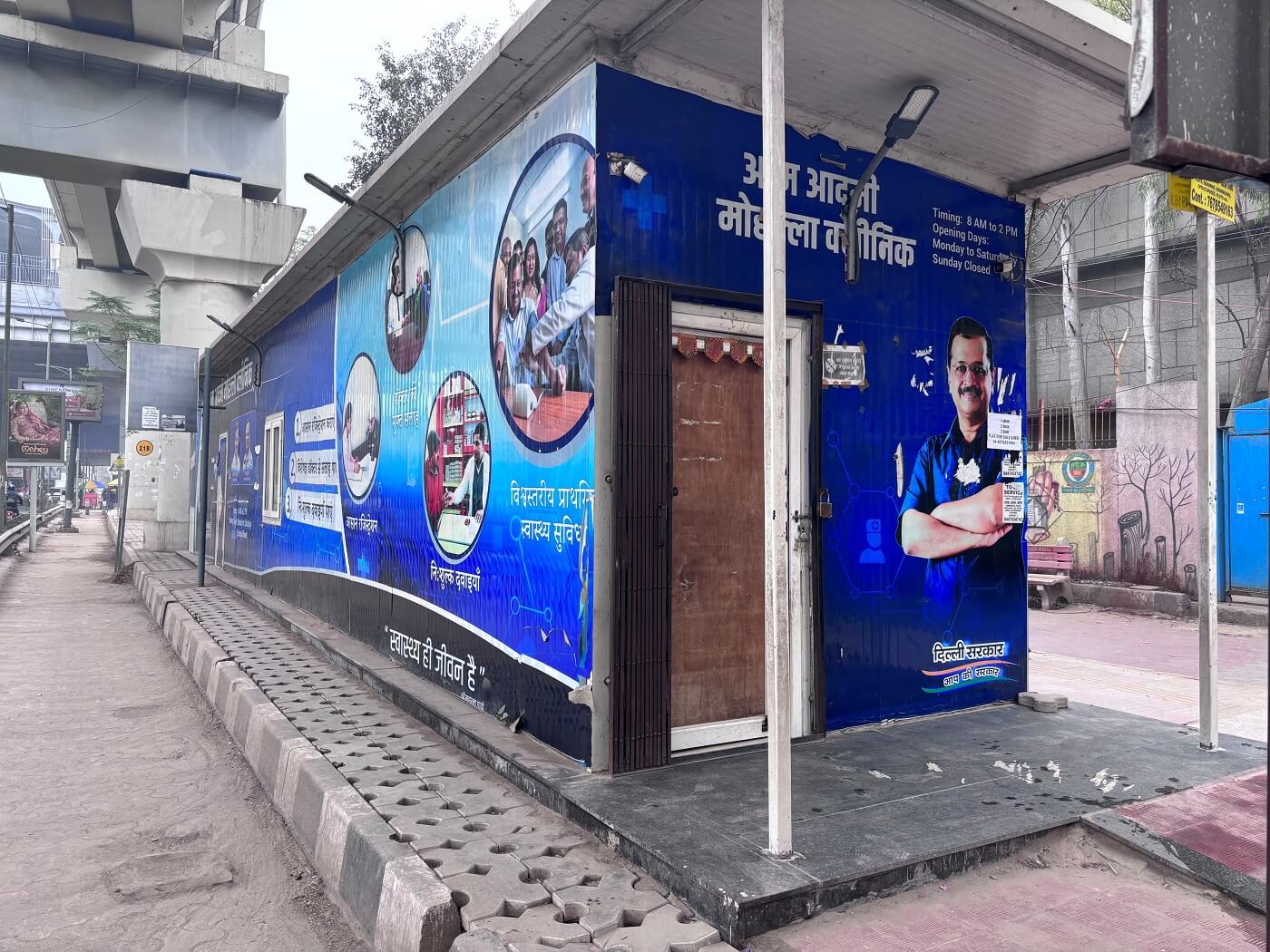
Photo: Indrajit Thakur
Think Delhi pavements, and visions of busy elbows weaving through hawkers’ kingdoms, the aroma of sizzling samosas drifting, and images of mouth-watering chaats conjure up. But these bustling paths are more than just concrete; they are a canvas for urban adventures, chaotic yet charming. Competing interests for the space exist here too but large parts of the city are served by footpaths that are relatively wider than in other cities such as Mumbai.
The ‘encroachment’ here is also not by the informal alone, the state government used certain footpaths to set up mohalla clinics. It saved tricky land acquisition and also provided people with primary healthcare near a metro station or bus stop. The city’s pavements are also parking spaces, unfortunately, in VIP zones much to the chagrin of people. Pavements also act as walking space for domestic pets offering them a canvas for sniffing adventures and tail-chasing matches – and their nature calls. But public toilets for people, which could be on pavements, are as elusive as cheap accommodation in the city.
The footpaths offered solace too. When Delhi flooded massively in July last year, as the rainfall breached all records, they were turned into space for makeshift tents in certain areas of the city, providing shelter for the displaced.
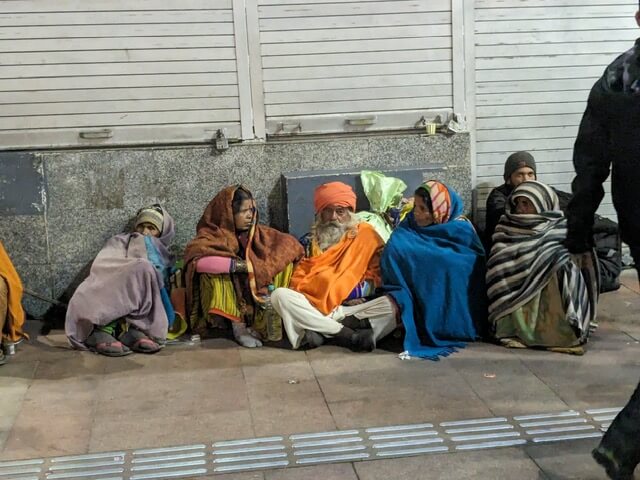
Photo: Sudip Sen
Another stark picture on Delhi’s pavements is the homeless, who struggle to keep warm during winter. As night falls and temperature dips, they huddle together around a fire on the city’s pavements, especially those who cannot find room in shelter homes or are turned away from them. According to India’s 2011 census, around 47,000 of the city’s residents were homeless, but activists say New Delhi has more than 1.5 lakh people without homes.[4]
Kolkata
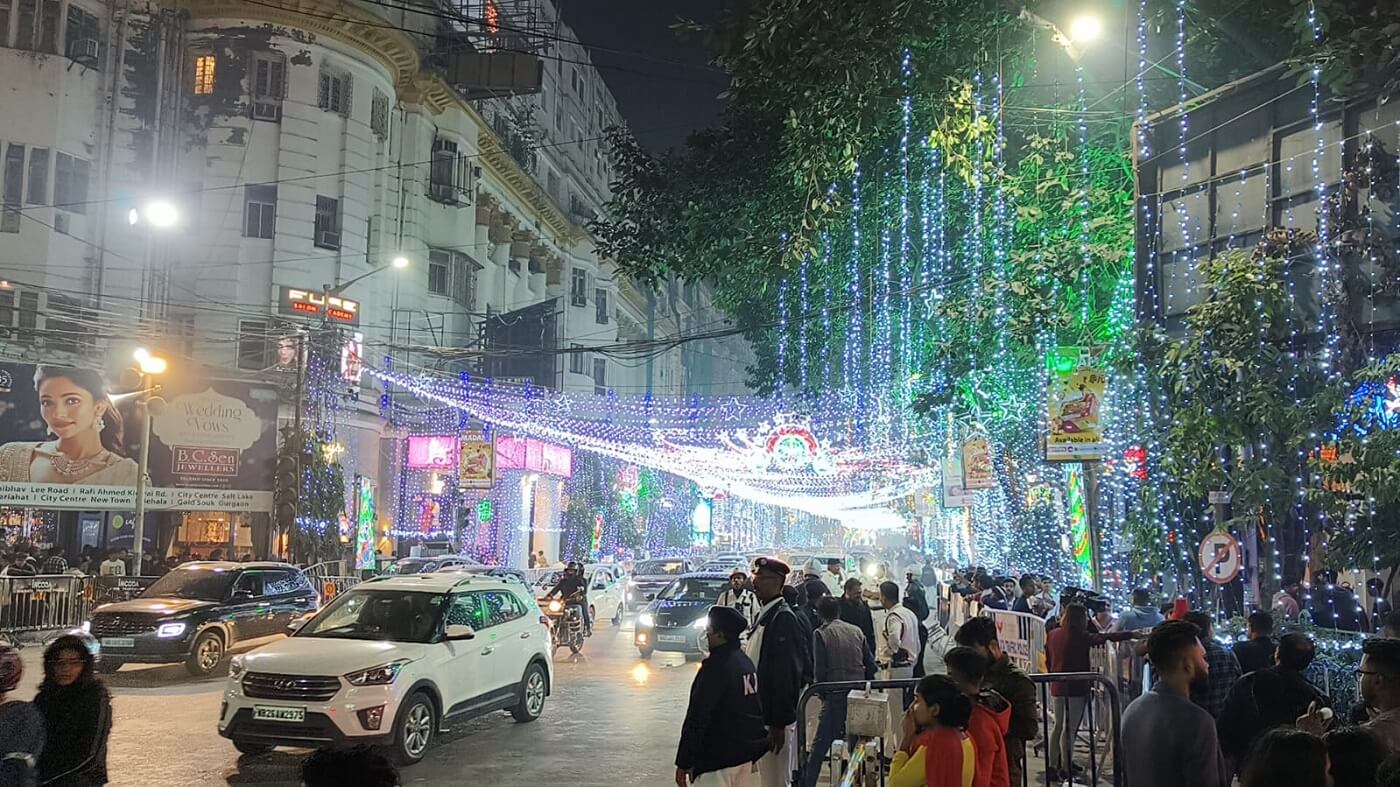
Photo: Rakhi Ghosh
Kolkata’s multiculturalism is best reflected during Christmas when Park Street, in the heart of the city, is bathed in a festive glow. What better way to admire the decoration than taking a walk down? Lakhs show up at the nerve centre of the city, soaking up the carnival spirit and the nip in the air. There is food, music, and love — ingredients that carry the rich legacy of the city. As the street turns into a celebration zone, the pavements see a regular stream of people shopping, eating, or just walking by – a perfect example of how integral a pavement is to the larger built environment.
“Walking here during this time is a test of patience and resilience. You walk with the flow, become a part of the huge crowd and merge with the unfamiliar faces,” says Pratik Ghosh, who works in Mumbai but makes it mandatory to experience the Park Street fervour every year-end.
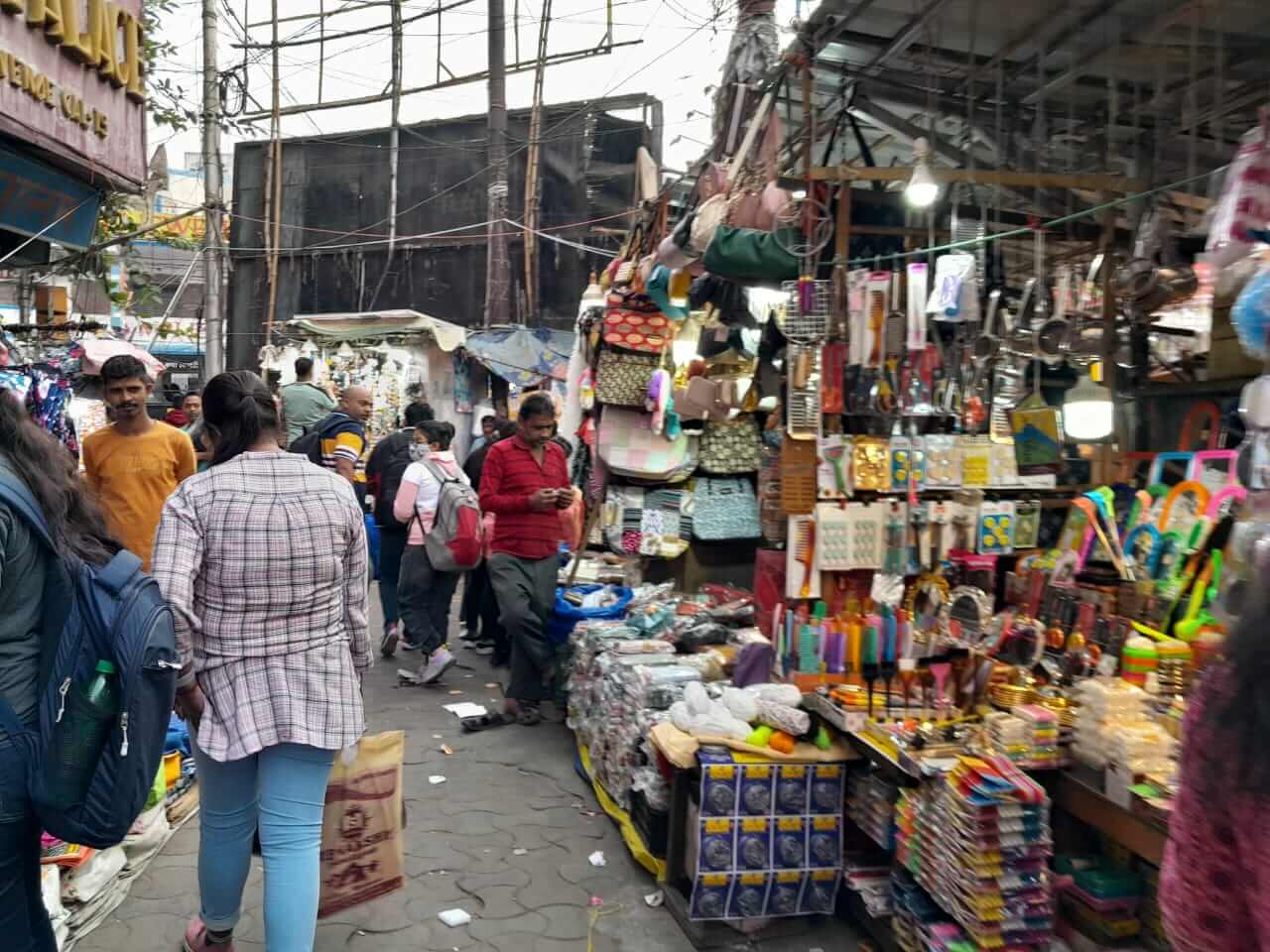
Photo: Rakhi Ghosh
Kolkata, as other cities, is known for its footpath markets. Crockery, kitchen accessories, garments, footwear, sarees — name it and you will find it in the rows of shops on the footpaths. Gariahat in Kolkata is a popular street shopping hub for local items and traditional sarees and jewellery. Open on all days, the footpaths are the never-ending line of stalls, selling a variety of local products and trendy clothes and footwear.
Mumbai
The city has seen its share of unresolved pedestrian versus hawker debates over the years. But does it have to be a conflict?
Yogesh has been running his father’s roadside stall selling cigarettes and snacks for over four decades now. He has seen it go from a kaccha structure to a pucca stall over time: “My father has owned this shop since the 1980s. I’m 44 years old and this has been our family business. There have been times where people used to tell us to leave, that we are ‘illegal’, that we are not supposed to be here – but once we got a licence and registration number, they stopped harassing us. I have seen so many of the same people every day, coming for snacks and sutta. Jaan-pehchaan si ho gayi hai.”
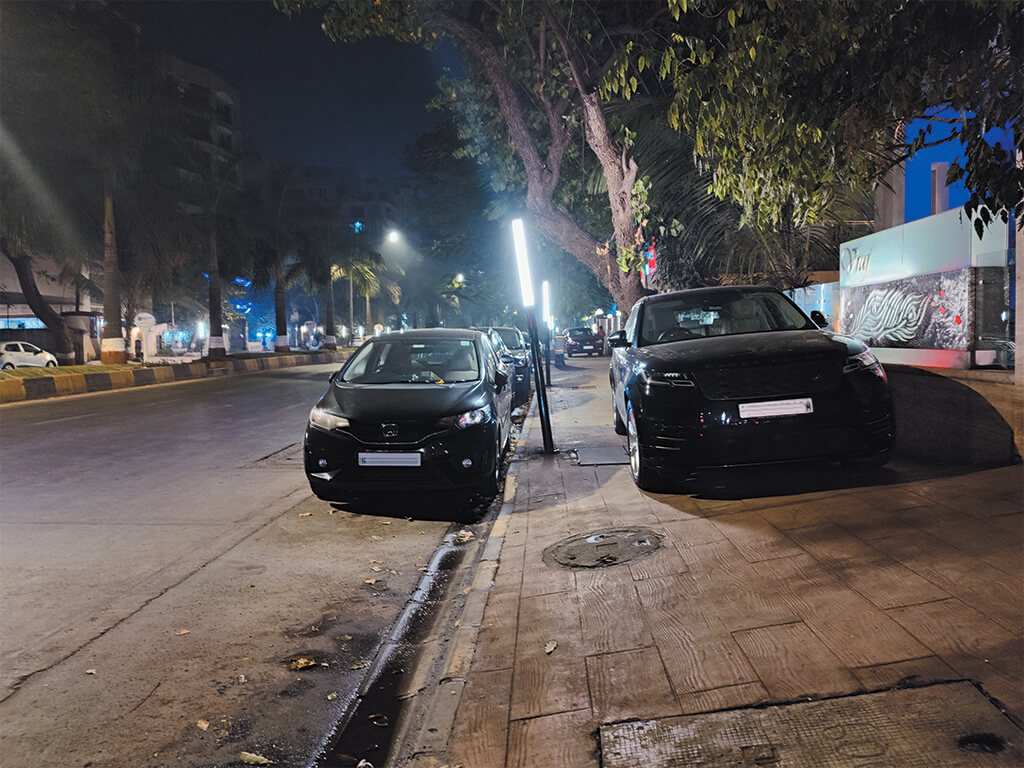
Photo: Shivani Dave
Pedestrians are often seen walking on the road even when there are footpaths. Besides the intruding presence of hawkers, people spoke up in frustration about the materials used and maintenance. “I love walking around, it’s my preferred way to catch up with friends. I usually stroll around my house near Vile Parle station or walk around Juhu but I consciously avoid footpaths. Even though Juhu is much better than most areas for footpaths, it’s not ideal. Tiles are broken, there’s dog droppings, hawkers, parked cycles and rickshaws, then there are no lights and hidden nooks that don’t feel safe,” says Aayushi Parekh, 27.
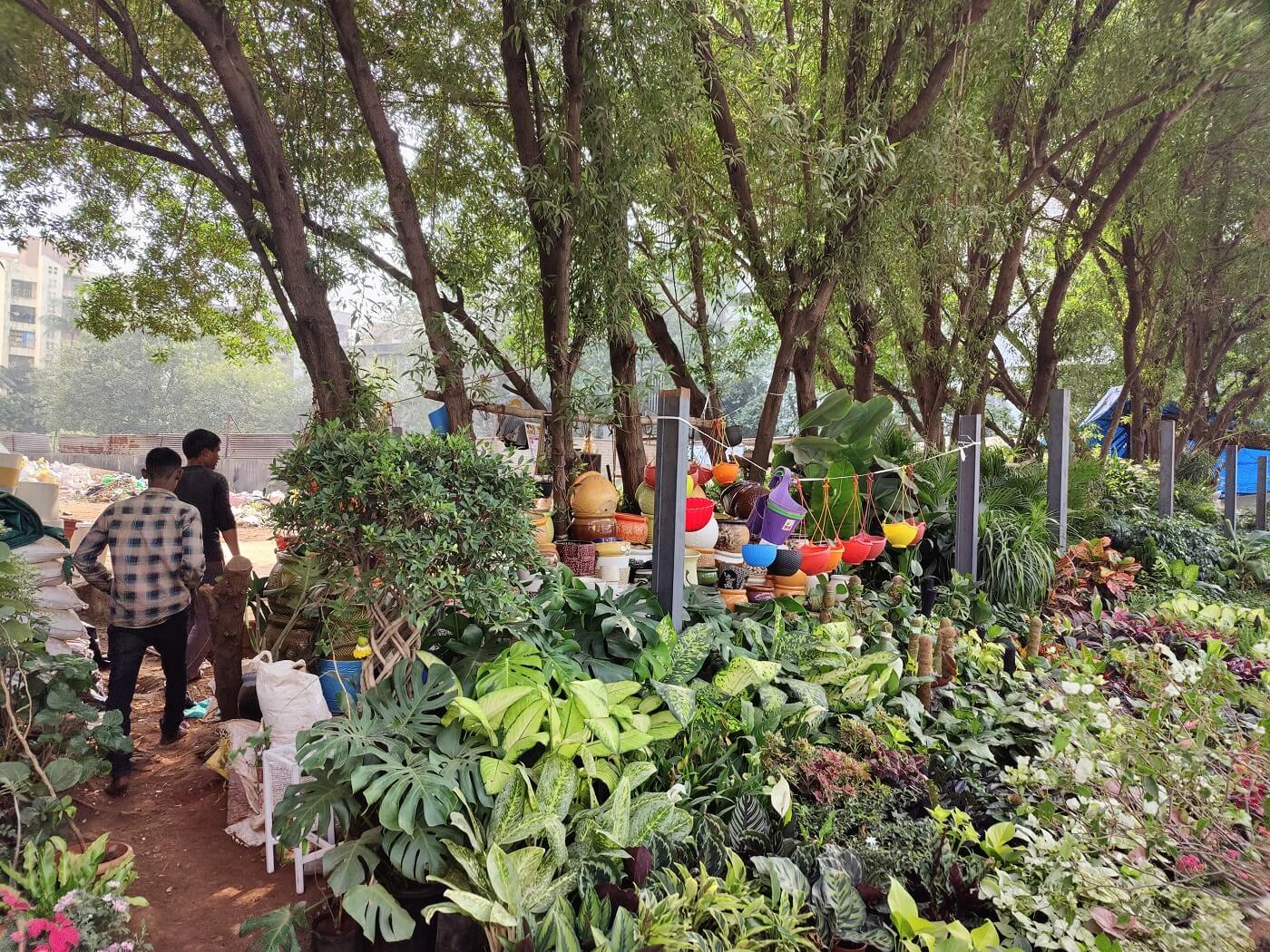
Photo: Shivani Dave
Avinash has been running a small nursery by the nullah near Irla market for the last six months. He moved here from the suburb of Kalina, less than seven kilometres away, in the hope of earning more. “I only take care of the nursery, I’m hired for the job. It’s better here than in Kalina because a lot of people come walking here, or to the Irla market, or from colleges nearby. We live right behind the nursery on an unclaimed piece of land but it’s probably a matter of time till I have to leave again,” he says.
However, the footpath that his nursery skirts around is a mess – broken tiles, varying levels, two-wheeler drivers using it, barbers and more. This stretch exemplifies the bane of urban planning where planners accounted for cars and pedestrians without considering the many informalities that comprise the city. Such informalities are typical of most Indian, in fact South Asian, cities. While streets and footpaths oriented towards people are more economically productive,[5] badly designed spaces largely cut down people’s motivation to walk or occupy them.[6]
Bhubaneswar
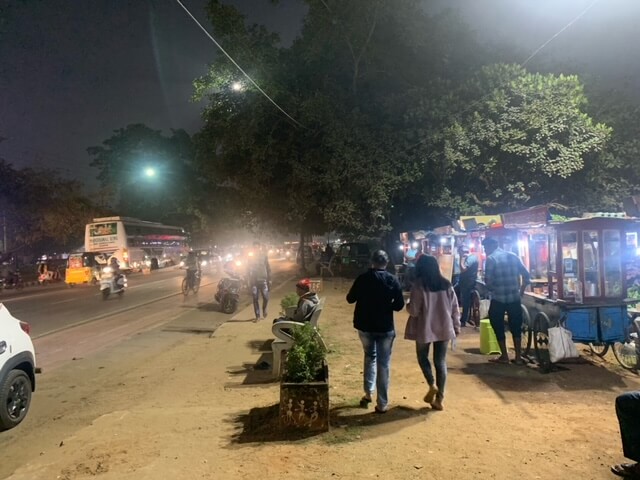
Photo: Shobha Surin
Bhubaneswar, the capital of Odisha and among the first planned cities of independent India, was designed to aid seamless mobility. Over the past few years, as the city extended its areas, pedestrians were slowly sidelined and the newer designs were hardly people-centric – until the Smart City project came about. The smart roads, completed in the past two years, have not only provided ample space to pedestrians but also to hawkers. The footpaths are, of course, walkable but the scattered benches on them ensure you can sit to have a bite or simply while away time.
The city’s interaction with these public spaces is reviving but in a few select pockets. Some arterial roads have hardly left any space for footpaths. The posh and elite localities have distinct footpaths and dedicated cycling tracks with manicured greenery around –a delight for joggers, walkers, and cyclists. But this is not uniform throughout the city. As the city expands, planners should make the newly- developed areas more walkable with accessible pavements while accommodating vendors.
Art, performances and pavements
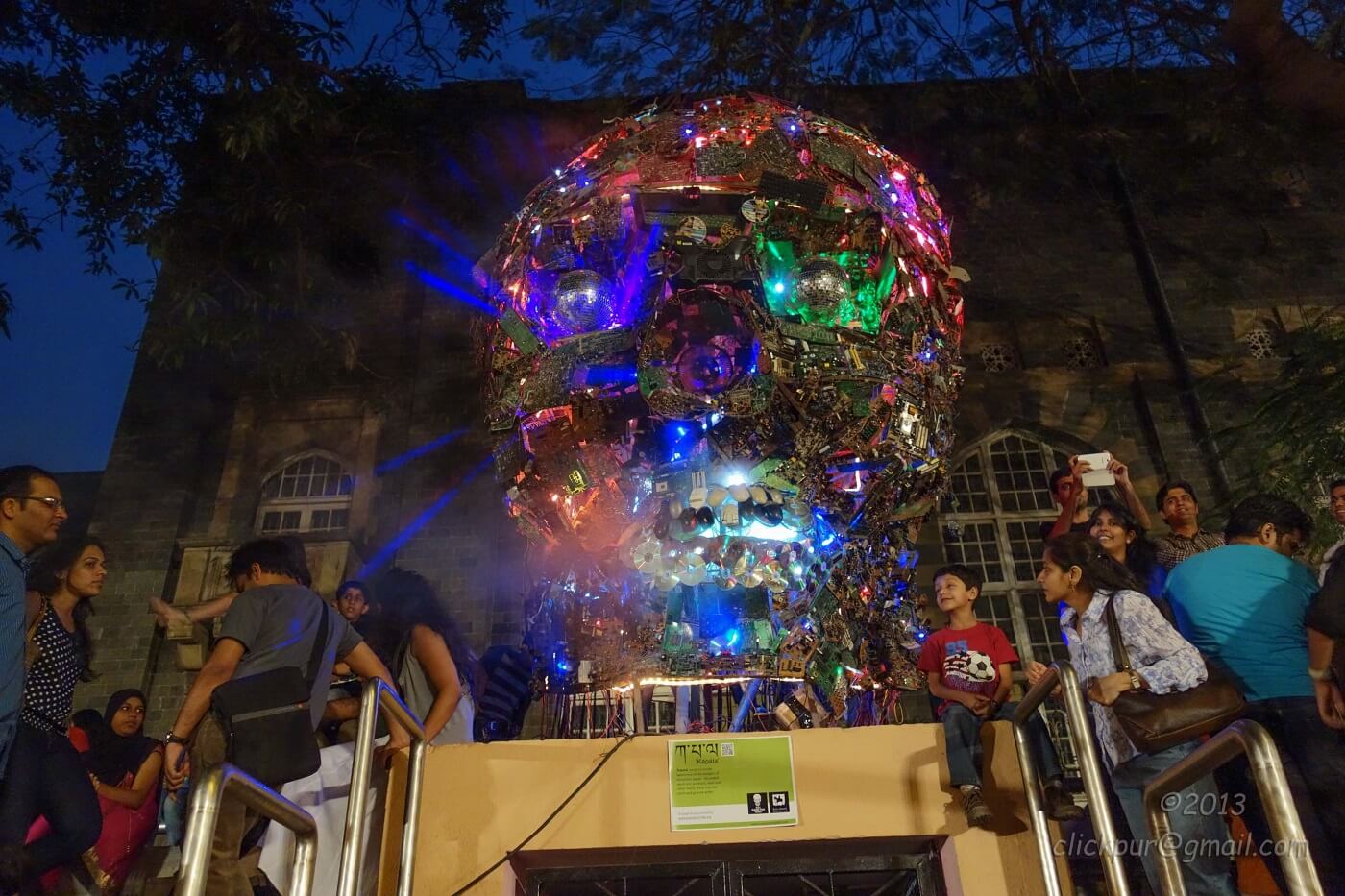
Photo: Udaykumar PR/Wikimedia Commons
Busking is one of India’s many street activities that has reduced over the years. Madaris (street performers in Hindi) are often seen lining busy pavements to earn money through donations. Street magicians, acrobats, musicians, snake charmers and more are often considered to be ‘informal’, while exhibitions, like the Kala Ghoda Arts Festival or Kolkata Street Art Festival are considered ‘formal’. This is not to say that one is better than the other, but to acknowledge the various types of performances, art and otherwise, that are seen on our pavements.
Live painting, artist sculptures, workshops and musical performances proliferate streets and footpaths providing us with a city-level cultural experience. Since footpaths are not planned for activities other than walking, these often extend onto the road. Space is not made for informalities but these festivals prove the need for public space at a larger scale.
It is reported that art on footpaths increases pedestrian safety[7], while also encouraging pedestrian use. In India, the Aravani Art Project[8] is a public art collective run by trans and cis women who paint their stories through murals in public places across the city. Small and large scale interventions like these break a city’s otherwise-formal fabric to increase social activities and connections through one of the most important public amenities – footpaths.
Protests and pavements
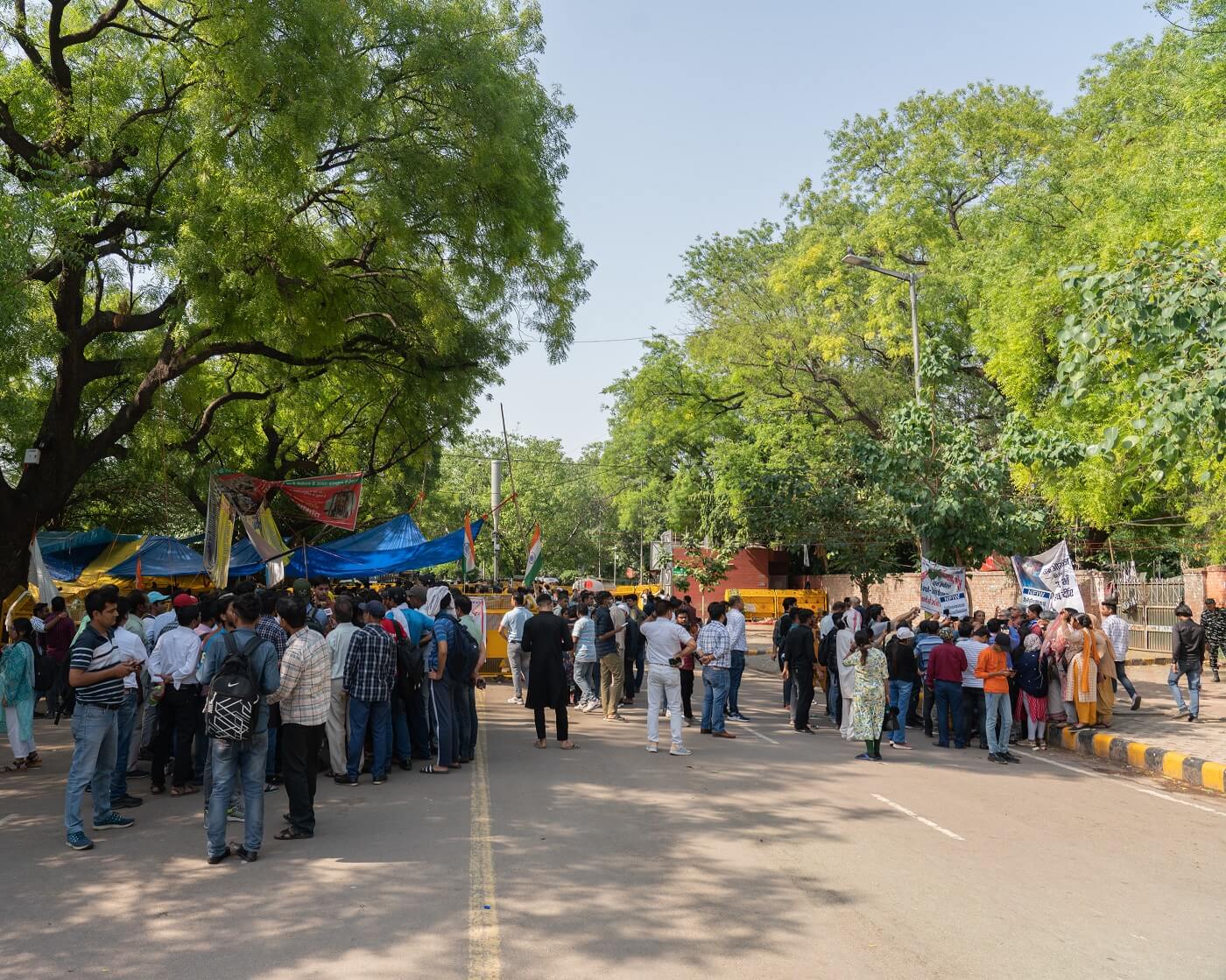
Photo: Satdeep Gill/Wikimedia Commons
Pavements have long been used as protest sites. Even after agitations moved to bigger spaces, the easily accessible pavements are used as assembly points to raise voices. As pavements are technically ‘public spaces’ i.e. open and accessible to all, they are often the first sites for all kinds of social engagement.[9]
The wrestlers’ protest last year[10] spilled on to Delhi’s pavements as they continued their long fight against the Wrestling Federation of India and its former chief Brij Bhushan Sharan Singh alleging sexual harassment. India’s top wrestlers, who have won medals for the country, sat on the pavement demanding action against Singh.
Students of Panjab University in Chandigarh used to protest holding placards on a 10-metre-long pavement outside the vice-chancellor’s office. As the number of protesters started increasing, the university got the pavement dug up in June last year to raze the protest site and mute the voices. [11]
Food and pavements
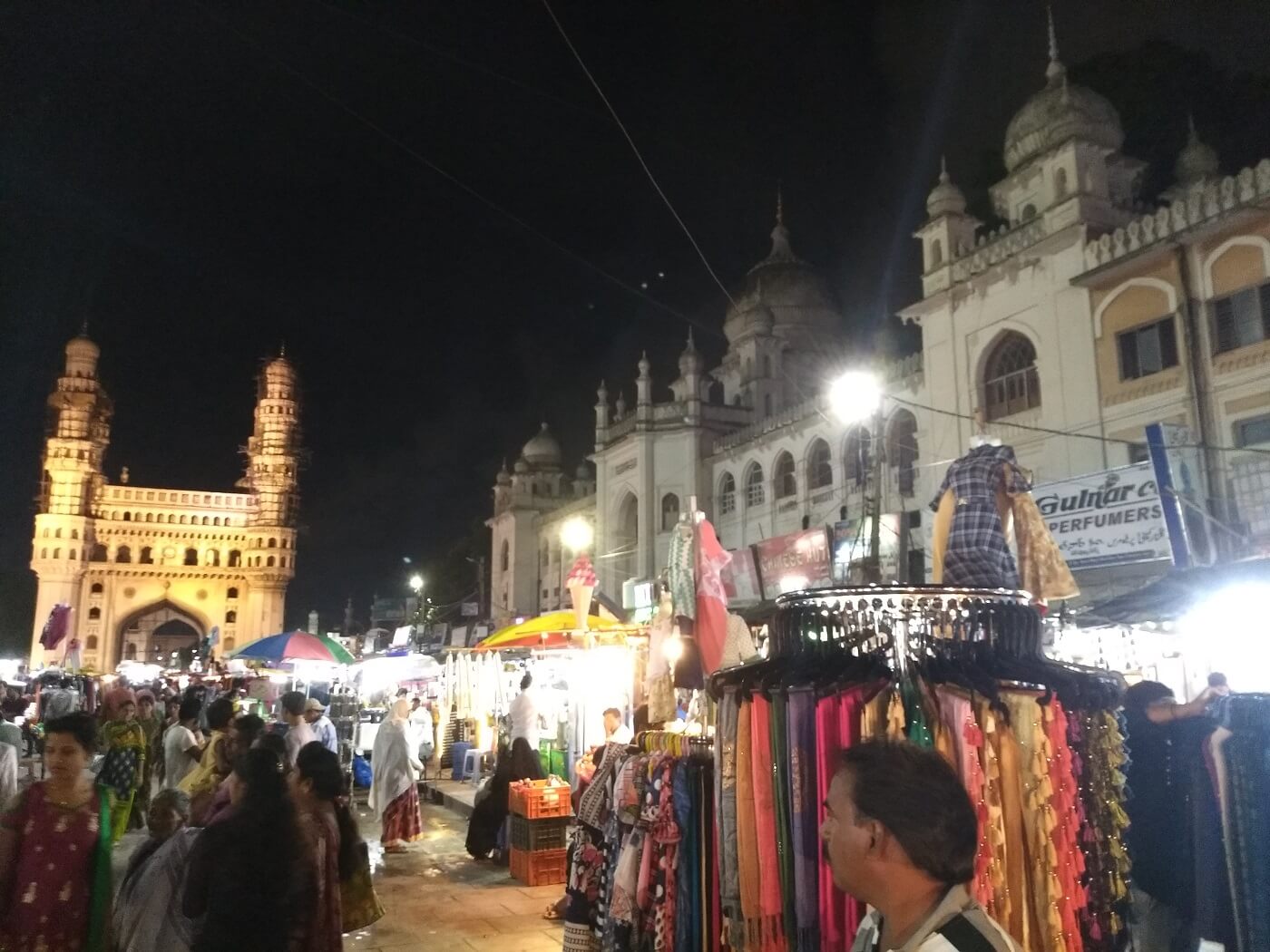
Photo: Wikimedia Commons
The month of Ramzan sees prayer and feasting on footpaths around the Charminar in Hyderabad, as in other cities too. Pavements sport newly-opened stalls selling special delicacies. Every evening, lights go up and footpaths are filled with sellers, foodies, tourists and locals at iftar. On the eve of Eid, as the area swells with shoppers throughout the night, the footpaths are filled with women getting mehndi applied on their hands.
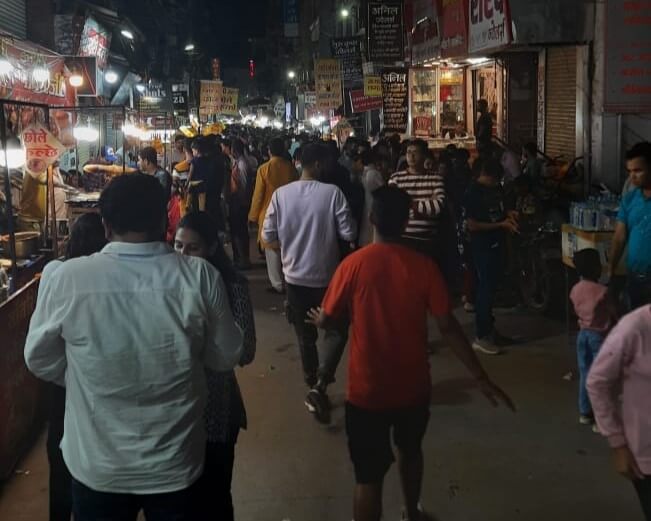
Photo: Suditi Gupta
Indore is known for its street food culture. The city’s lanes, streets and footpaths are filled with food joints, stalls and eateries. Not that anyone minds. Sarafa Bazar is among the oldest food hubs in the city; a jewellery market in the morning, it turns into a foodie’s paradise in the evening after the big shops shut. Sarafa’s night street market is the oldest and attracts a lot of tourists, foodies, chefs and the locals. The pavements are filled with customers as they wait for piping hot food to be served.
Across India’s cities, without food and food stalls, footpaths would be lonelier too.
Shivani Dave is an architect, writer and illustrator interested in exploring the intersection of architecture and social sciences. After graduating in architecture from Mumbai, and in media from the London School of Journalism, she is applying the fundamentals of architectural research and writing within urban contexts to develop phenomenological ideas about life in cities. She researches, writes and illustrates in Question of Cities.
(With inputs from Sudip Sen in Delhi)
Cover photo: Chai tapris, men’s groomers and loiterers are often seen on Mumbai’s footpaths. Credit: Shivani Dave

